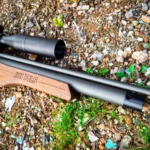Tired of leaky waders? In this guide, I’ll show you how to repair breathable waders, so you can get back on the water in no time.
After a heavy 2021 of fly fishing, my Simms waders developed a leak in the neoprene bootie. It is one of those miserable feelings standing in the water and feeling the cold water creep in.
The good news was that I had wool socks so it wasn’t too cold but my whole right leg was soaked.
Many people would send them back to the manufacturer but I had heard stories about how long Simms was taking to repair waders. People were telling me that they were going to have to wait months before Simms would repair their waders.
I had repaired a pair of GoreTex Simm’s waders before that I cut open on a rock so I knew how to fix the legs, but I didn’t really know how to fix the bootie-or if that was even possible.
As it turns out, Simms does not recommend repairing the booties at the seam. So, if you have a leak in the seam, you are better off sending it for them to put on new booties.
My hole appeared to be in the big toe area and nowhere near the seam, so I gave it a try. Low and behold, it worked perfectly.
A fishing friend of mine is sitting on several pairs of leaking waders because he won’t try to fix them himself. Well, to be honest, he tried once, and it didn’t turn out well for him or the waders. I think he’s waiting on me to offer to do it for him.
So, if you find yourself in the same situation, here are the steps I took:
Table of Contents
Identify The Leak
There are a few ways to identify leaks. One way is to turn your waders inside out. Put rubbing alcohol into a spray bottle and spray the legs of the waders, seat area, and chest. Basically, any place you want to check for leaks.
Holes show up as a little black dot.
Circle those dots with a magic marker.
Another way is to fill the waders with water. However, Simms cautions that you should not fill the entire wader all the way to the top but only as high as the knee area. Anything more and you risk damaging your waders because of the weight of the water can rip seams. In my case, I could see that the neoprene was worn right near my big toe.
In my research, I discovered that the big toe was one area that was frequently damaged by rubbing or large toenails.
Rips and tears are pretty obvious. In my case, I could easily see through my waders to know I had worn away the neoprene in the bootie.
Get Yourself Some Aquaseal And Patches
Aquaseal will be your friend.
This rubber cement-type product is highly recommended by wader companies for repairs. It is durable and flexible and works on waders, neoprene wetsuits, and dry bags for repairs that last.
Simms and Aquaseal offer wader repair kits that include Tenacious Tape patches to make the repairs more precise and permanent. I highly suggest getting these kits because everything you need is right in the kit.
Be Patient And Build Layers.
The key to using Aquaseal is to make sure you don’t glob it on all at one time, but you put build it up in layers. I just used a little bit at first over the worn area. I went a little larger than the worn area and let it dry overnight.
Let the area cure.
The next day, I put a little more on and let that dry. I did this for about 3 days straight.
By the end, the Aquaseal glue had dried nicely, and I tested the bootie again by filling it up with water and it held.
Don’t Do It All At One Time
My friend who is waiting for me to do his wader repairs can be impatient at times.
So, he put Aquaseal on all the black dots that he saw, turned the waders over and somehow the legs got stuck together. I recommend that you do one leg at a time, or the front or the back at a time, let it dry and switch.
Don’t let the legs touch while the glue is still wet, or you will be like my friend and have a pair of Simms G4’s where the legs are glued to each other.
Test Your Repair
There is nothing worse than having ice-cold water steep into your waders on a cold winter day on the river. So, test your repair.
If you can fill your waders with water because your repair is below the knee, test them by filling them up to the knee. That’s how I tested my booties.
If they are above the knee, then spray the alcohol again on your waders and look for the black dots.
The good news was that using the technique above, I now have a dry pair of waders and it only took a few days to repair. If you have the time, most wader companies will offer to do repairs. You will have to be patient. Or you can give it a try and do it yourself.
One pro tip that I read says to store your Aquaseal in the freezer.
When you want to use it, put it in warm water to heat up. I can’t tell you if this works or not because I just put it in a Ziploc bag and put it in the freezer. I haven’t needed to use it since my initial repair.
Good luck and hope to see you on the river!








































![Air gun 101: The differences between .177 & .22 – Which jobs they do best ? [Infographic]](https://airgunmaniac.b-cdn.net/wp-content/uploads/2024/11/1773-150x150.jpeg)